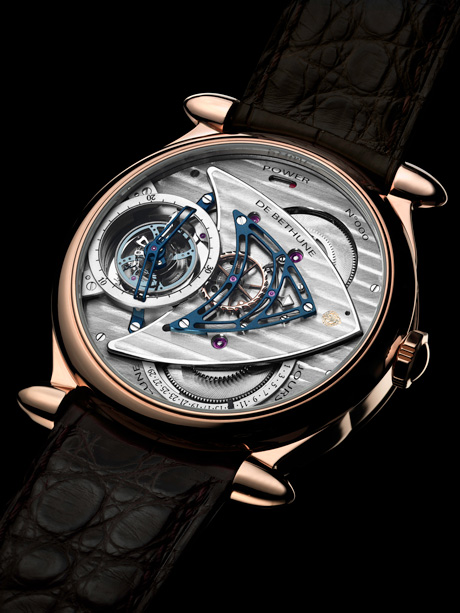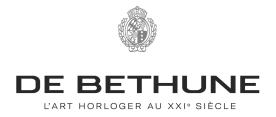De Bethune continues research into modern accuracy while retaining the common sense roots of classic horology, with quality and style coming out the big winner.
Denis Flageollet, the creative and technical force behind De Bethune since its inception in 2002, focuses on highly progressive watchmaking. This becomes apparent when you look at the incredible – at times even mystifying – timepieces that have emerged thus far, watches that proudly wear their roots in traditional horology if you look for them.
At the De Bethune workshop in La Chaux l’Auberson, a village located near Ste Croix, Flageollet, in typical watchmaker tradition, chooses to live and work in much the same type of environment filled with peace and much solitude. “It’s important for me to work in a comfortable place, away from the rest,” he says of his isolated workspace, one that effectively does not even include a telephone. He makes sure to have plenty of quietude to work on his at times futuristic concepts, which he for the most part chooses to share with the rest of the horological world.
Flageollet took a few minutes to talk to me about what’s happening at De Bethune, where a total of 15 watchmakers (5 alone in research and development), two technicians and four engineers work with Flageollet to further the progression of watchmaking and make ever more interesting timepieces. “Among the numerous studies we have ongoing, we continue to work on high-frequency resonators and new types of gear teeth,” he reveals before uttering the words perhaps all enthusiasts of fine modern watchmaking have been waiting to hear. “We are in the final phase of our chronograph movement and in parallel, one part of the technical team is working on astronomic indications.”
 Wait…did he just say there will be a De Bethune chronograph? While it was definitely something that has been missing in the collection for sure, it seems such a mundane thing for Flageollet to work on when you look back over eleven years of his output. Naturally, knowing Flageollet, it will include something unexpected – we will unfortunately have to wait and see.
Wait…did he just say there will be a De Bethune chronograph? While it was definitely something that has been missing in the collection for sure, it seems such a mundane thing for Flageollet to work on when you look back over eleven years of his output. Naturally, knowing Flageollet, it will include something unexpected – we will unfortunately have to wait and see.
 Wait…did he just say there will be a De Bethune chronograph? While it was definitely something that has been missing in the collection for sure, it seems such a mundane thing for Flageollet to work on when you look back over eleven years of his output. Naturally, knowing Flageollet, it will include something unexpected – we will unfortunately have to wait and see.
Wait…did he just say there will be a De Bethune chronograph? While it was definitely something that has been missing in the collection for sure, it seems such a mundane thing for Flageollet to work on when you look back over eleven years of his output. Naturally, knowing Flageollet, it will include something unexpected – we will unfortunately have to wait and see.
Star Trek bridge
Perhaps the new chronograph will include one of the most striking and obvious elements De Bethune has brought out over the years in its wristwatches: the triangularly shaped bridge, often high-polished to attract attention and looking like decided science fiction. One such mirror-polished stainless steel version of the bridge is prominently displayed on the DB28T Black introduced at Baselworld this year in hand-wound Caliber DB 2115. Flageollet calls the bridge shape practical, for it seems obvious to him that this has to be better than four separate bridges. “It’s function and form together,” he explains. “The shapes of the parts are natural for what it is they need to do,” he continues, also including the shape of the balance in his explanation. “De Bethune employs a concept of being classic but modern; a new classic. I simply think there are not enough beautiful and classic watches out there.” He stresses that he is able to work with such unorthodox shapes only because they are produced in-house, without having to go through the usual Swiss supplier odyssey before coming to fruition.
Speaking of the balance, it should be noted that De Bethune was the first to use a titanium balance wheel in its forward-thinking movements. The 2003-perfected component was first seen at the 2004 edition of Baselworld. Ensconced in De Bethune’s Isochronic Oscillating System (IOS), the titanium in the center is surrounded by platinum on the outside weights for an ideal inertia-mass ratio, eliminating the need for screws or index mechanisms to adjust it. It also includes a silicon balance spring patented by the company that ends in a terminal plane curve. The concept of the terminal curve is based on Breguet’s discovery of the fact that the form of the terminal curve is of utmost importance to the quality of the balance spring’s performance. The curve helps achieve isochronism and eliminate lateral pressure. The Breguet overcoil, which is the most common type of balance spring with terminal curve, is bent upward, while De Bethune’s silicon balance spring possesses a terminal curve that remains on the same level as the rest (allowing for thinner movement heights).


Light and isochronal
De Bethune’s balance is also outfitted with a triple parachute bridge, which is a shock absorber system containing a titanium bridge, allowing the company to create what Flageollet calls the “lightest isochronic oscillating system in the world.”
“Our studies of the silicon balance spring have been done here in-house at De Bethune,” Flageollet explains. “It is the logical result of the studies of the titanium-platinum balance with De Bethune’s terminal curve. We chose to use silicon because it is the best material for great precision and perfect control needed for working with numerous laboratories all over the world. This technology has been used for more than thirty years by high-tech industries, adapted for electronics, for example. De Bethune’s silicon elements are manufactured by a process developed by De Bethune in a foreign laboratory completely independent of any other research currently taking place in the industry.” De Bethune is also experimenting with a resonance technology called Résonique that eliminates the need for a balance altogether.
Flageollet explained that when De Bethune registers a patent, he is essentially interested in the fundamental principles of what he is patenting and not necessarily the manufacturing process – the what rather than the how. “Concerning the patent of De Bethune’s balances, the maximum inertia yield for the minimum balance weight is interesting; not the material used to get there. We effectively began with titanium in 2003, but after eleven years of research, we have found other usable materials. We are always happy to regularly serve as a guide to the industry, which is why we oftentimes share our discoveries instead of patenting them.”
 Justifiably proud of his brand’s developments, Flageollet cites their departures from the classic while retaining elements of haute horlogerie as being so exciting. “One sees all of the mechanics, volume, a difference between the various levels.” He’s right; De Bethune timepieces look much like wearable sculptures; works of art that only a few collectors every year can get their hands on.
Justifiably proud of his brand’s developments, Flageollet cites their departures from the classic while retaining elements of haute horlogerie as being so exciting. “One sees all of the mechanics, volume, a difference between the various levels.” He’s right; De Bethune timepieces look much like wearable sculptures; works of art that only a few collectors every year can get their hands on.
 Justifiably proud of his brand’s developments, Flageollet cites their departures from the classic while retaining elements of haute horlogerie as being so exciting. “One sees all of the mechanics, volume, a difference between the various levels.” He’s right; De Bethune timepieces look much like wearable sculptures; works of art that only a few collectors every year can get their hands on.
Justifiably proud of his brand’s developments, Flageollet cites their departures from the classic while retaining elements of haute horlogerie as being so exciting. “One sees all of the mechanics, volume, a difference between the various levels.” He’s right; De Bethune timepieces look much like wearable sculptures; works of art that only a few collectors every year can get their hands on.
“We have succeeded in realizing a good balance between innovation, production and reliability. Quality is the most important word; we are not looking to make more products, but to make better ones.”
Featured brand







